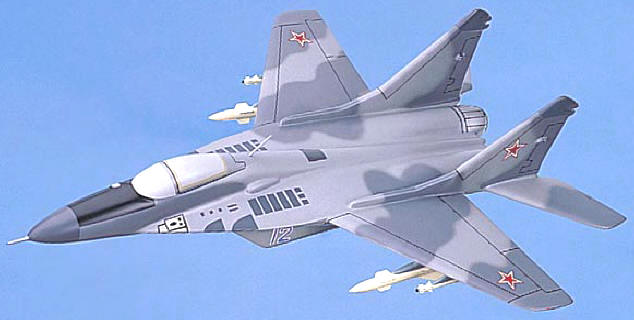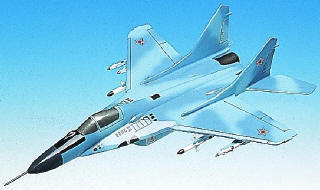|
|
|
 |
Mig-29
Fulcrum |
The
MiG-29, -30 and -33 are known by the NATO code name
Fulcrum. Designed in 1972 as a replacement for the MiG-21
and MiG-23 in the fighter role, the Fulcrum slightly resembles
the F-15 in basic configuration, but with the size of the
smaller F/A-18. Despite the fact that the MiG-29 was not built
with a fly-by-wire flight control system, it still has
incredible agility and maneuverability. The first
prototype flew on October 6, 1977 and entered service as the
initial 'Fulcrum-A' in 1984. Combat capable two-seat trainers
followed shortly thereafter. The 'Fulcrum-C' featured a deeper
fairing, which allowed most of the avionics to be moved from the
lower fuselage to provide more room for internal fuel. A
'Fulcrum-D' was designed for carrier based use, but was rejected
in favor of Sukhoi's carrier borne Su-33 'Flanker'.
The MiG-29K is the carrier-based
fighter used by the Russian Naval Air Force. The mission
of the MiG-29 is to destroy hostile air targets within radar
coverage limits and also to destroy ground targets using
unguided weapons in visual flight conditions. The aircraft's
fixed-wing profile with large wing leading edge root extensions
gives good maneuverability and control at subsonic speed
including maneuvers at high angles of attack.
'Fulcrum' is an impressive aircraft,
with good performance, armament and maneuverability, and the
ability to use rough airfields. Range is weak point, and later
versions were modified to carry more fuel. A navy version has
also been flown. The Russian air force prefers the larger Su-27
and its derivatives, but the development of the advanced MiG-29M
version has been funded recently. |
 |
Mig-29 Fulcrum
Premier Series. Loaded with weapons. 1/45th scale.
11.5" wingspan x 19.5" long.
No. AGW2D-PR. Only $184.95 |
 |
Mig-29 Fulcrum
Standard Series. 1/48th scale.
10.15" wingspan x 14.75" long
No. AGW2D-ST. Only $119.95 |
|
|
